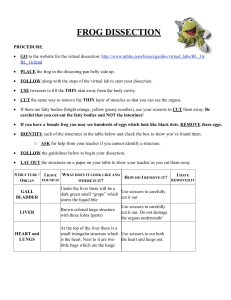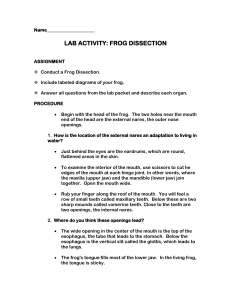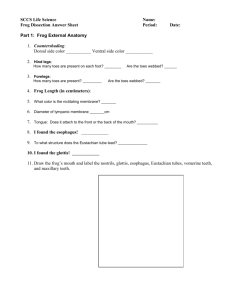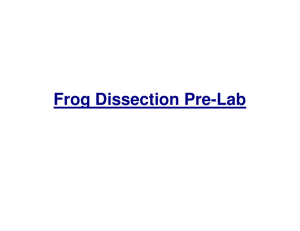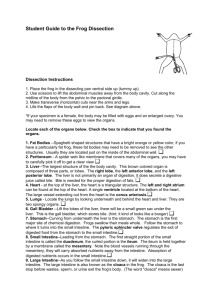Frog Dissection
advertisement
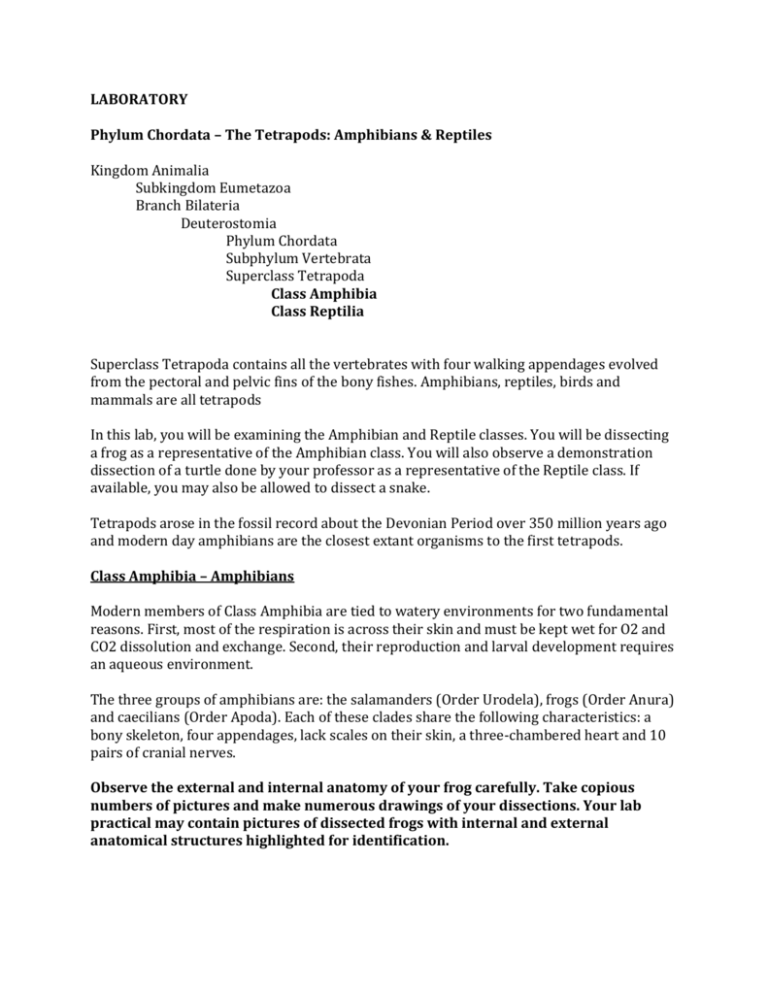
LABORATORY Phylum Chordata – The Tetrapods: Amphibians & Reptiles Kingdom Animalia Subkingdom Eumetazoa Branch Bilateria Deuterostomia Phylum Chordata Subphylum Vertebrata Superclass Tetrapoda Class Amphibia Class Reptilia Superclass Tetrapoda contains all the vertebrates with four walking appendages evolved from the pectoral and pelvic fins of the bony fishes. Amphibians, reptiles, birds and mammals are all tetrapods In this lab, you will be examining the Amphibian and Reptile classes. You will be dissecting a frog as a representative of the Amphibian class. You will also observe a demonstration dissection of a turtle done by your professor as a representative of the Reptile class. If available, you may also be allowed to dissect a snake. Tetrapods arose in the fossil record about the Devonian Period over 350 million years ago and modern day amphibians are the closest extant organisms to the first tetrapods. Class Amphibia – Amphibians Modern members of Class Amphibia are tied to watery environments for two fundamental reasons. First, most of the respiration is across their skin and must be kept wet for O2 and CO2 dissolution and exchange. Second, their reproduction and larval development requires an aqueous environment. The three groups of amphibians are: the salamanders (Order Urodela), frogs (Order Anura) and caecilians (Order Apoda). Each of these clades share the following characteristics: a bony skeleton, four appendages, lack scales on their skin, a three-chambered heart and 10 pairs of cranial nerves. Observe the external and internal anatomy of your frog carefully. Take copious numbers of pictures and make numerous drawings of your dissections. Your lab practical may contain pictures of dissected frogs with internal and external anatomical structures highlighted for identification. Frog Dissection: External Anatomy 1. Observe the dorsal and ventral sides of the frog. Dorsal side color ___________ Ventral side color ____________ 2. Examine the hind legs. How many toes are present on each foot? ________ Are the toes webbed? ______ 3. Examine the forelegs. How many toes are present? _________Are the toes webbed? _______ 4. Use a ruler to measure your frog, measure from the tip of the head to the end of the frog's backbone (do not include the legs in your measurement). Compare the length of your frog to other frogs Your Frog (cm) Frog 2 Frog 3 Frog 4 Frog 5 Average Length 5. Locate the frog's eyes, the nictitating membrane is a clear membrane that attached to the bottom of the eye. Use tweezers to carefully remove the nictitating membrane. You may also remove the eyeball. What color is the nictitating membrane? _________________ What color is the eyeball? __________________________ 6. Just behind the eyes on the frog's head is a circular structure called the tympanic membrane. The tympanic membrane is used for hearing. Measure the diameter (distance across the circle) of the tympanic membrane. Diameter of tympanic membrane _______cm 7. Feel the frog's skin. Is it scaley or is it slimey? ____________ Anatomy of the Frog's Mouth Procedure: Pry the frog's mouth open and use scissors to cut the angles of the frog's jaws open. Cut deeply enough so that the frog's mouth opens wide enough to view the structures inside. 1. Locate the tongue. Play with the tongue. Does it attach to the front or the back of the mouth? __________ (You may remove the tongue). Draw a sketch of the tongue, paying attention to its shape. Tongue Sketch: 2. In the center of the mouth, toward the back is a single round opening. This is the esophagus. This tube leads to the stomach. Use a probe to poke into the esophagus. 3. Close to the angles of the jaw are two openings, one on each side. These are the Eustachian tubes. They are used to equalize pressure in the inner ear while thefrog is swimming. Insert a probe into the Eustachian tube. To what structure does the Eustachian tube attach? _____________________ 4. Just behind the tongue, and before you reach the esophagus is a slit like opening. (You may need to use your probe to get it to open up). This slit is the glottis, and it is the opening to the lungs. The frog breathes and vocalizes with the glottis. Use your probe to open the glottis and compare that opening to the esophagus. 5. The frog has two sets of teeth. The vomarine teeth are found on the roof of the mouth. The maxillary teeth are found aroundthe edge of the mouth. Both are used for holding prey, frogs swallow their meals whole and do NOT chew. Run you finger over both sets of teeth and note the differences between them. 6. On the roof of the mouth, you will find the two tiny openings of the nostrils, if you put your probe into those openings, you will find they exit on the outside of the frog. 7. Identify and label as many of the structures you can find in the picture above. Frog Dissection Dissection Instructions 1. Place the frog in the dissecting pan ventral side up. 2. Use scissors to life the abdominal muscles away from the body cavity. Cut along the midline of the body from the pelvic to the pectoral girdle. 3. Make transverse (horizontal) cuts near the arms and legs. 4. Life the flaps of the body wall and pin back. *If your specimen is a female, the body may be filled with eggs and an enlarged ovary. You may need to remove these eggs to view the organs. Locate each of the organs below. Check the box to indicate that you found the organs. 1. Fat Bodies --Spaghetti shaped structures that have a bright orange or yellow color, if you have a particularly fat frog, these fat bodies may need to be removed to see the other structures. Usually they are located just on the inside of the abdominal wall. 2. Peritoneum A spider web like membrane that covers many of the organs, you may have to carefully pick it off to get a clear view 3. Liver--Examine the liver; it is composed of three lobes. One lobe lies on the right side of the frog. A large left lobe consists of two sub-lobes; verify this by lifting the more ventral sub-lobe and note its basal attachment to the other sub-lobe. The lobes are identified as: right, left anterior, and left posterior. Between the right and left lobe find the sac-like, bile storing gall bladder, greenish in color. The third liver lobe is small and lies dorsal to the gall bladder.. 4. Heart - at the top of the liver, the heart is a triangular structure. If necessary, lift or shift the liver gently until you locate the heart. On each side of the heart is a lung. The heart lies in a special part of the coelom, called the pericardial cavity. This space is separated from the remainder of the coelom by a membranous pericardium. Lift the pericardial membrane with forceps to slit it open and expose the heart fully. (Due to the injection process, this membrane may be partially destroyed. ) Identify the single thick-walled, triangular ventricle and the two more anterior, thin walled atria. Lift the apex of the heart and snip the slender strand of tissue that connects the atria to the dorsal wall of the pericardium. In this dorsal atrial region, well underneath the ventricle, locate the sinus venosus, a thin walled, membranous sac which collects all blood coming to the heart from the veins of the body. More specifically, three large veins enter the sinus venosus: the posterior vena cava (along the midline), and the anterior vena cava (laterally on each side). The sinus venosus itself empties into the right atrium (even though it appears to connect to both atria). The left atrium receives blood returning from the lungs via the pulmonary veins. These lie dorsal to the sinus venosus and will be difficult to see at this stage. Let the heart fall back to its normal position and locate the conus arteriosus, a single wide arterial vessel emanating from the ventricle and passing ventrally over the right atrium. Follow it forward to where it divides into two branches, each known as the truncus arteriosus. . 5. Lungs - Locate the lungs by looking underneath and behind the heart and liver. They are two spongy organs. 6. Gall Bladder --Lift the lobes of the liver, there will be a small green sac under the liver. This is the gall bladder, which stores bile. (hint: it kind of looks like a booger) 7. Stomach--Curving from underneath the liver is the stomach. The stomach is the first major site of chemical digestion. Frogs swallow their meals whole. Follow the stomach to where it turns into the small intestine. The pyloric sphincter valve regulates the exit of digested food from the stomach to the small intestine. 8. Small Intestine--In the small intestine, the first portion (which is somewhat straighter) is the duodenum. In the section that runs parallel to the stomach you will find the yellowish tissue of the pancreas, and important digestive gland that secretes pancreatic juice into the duodenum. This portion of the small intestine also receives bile from the liver and gall bladder. The bile duct from the gall bladder passes through the tissue of the pancreas where small pancreatic ducts open into the bile duct as well. The duodenum receives both bile and pancreatic juice through the same duct. Where the small intestine turns posteriorly again, the duodenum ends and the ileum begins. Generally the ileum can be considered the "curly" part of the small intestine, and the duodenum is the straight part just past the stomach. Along the coiled section of the ileum, note the mesenteries, a membrane that holds the coils together. The double membrane carries blood vessels and nerves. Held by mesenteries near the posterior end of the stomach, within the folds of the small intestine, is the reddish (or blue) spleen. It is not actually part of the digestive system, it is part of the circulatory system. Follow the small intestine (ileum) to where it widens: this is the large intestine. The hind portion of this part of the alimentary tract is covered by the urinary bladder, a thin-walled sac that holds urine. The large intestine opens into the cloaca. The word "cloaca" means sewer. Solid and urinary wastes exit the cloaca, as do sperm and eggs. The cloaca and large intestine are not clearly separated. The cloaca opens to the outside of the frog via the anus. . 9. Large Intestine--As you follow the small intestine down, it will widen into the large intestine. The large intestine is also known as the cloaca in the frog. The cloaca is the last stop before wastes, sperm, or urine exit the frog's body. (The word "cloaca" means sewer) 10. Spleen--Return to the folds of the mesentery, this dark red spherical object serves as a holding area for blood. 11. Esophagus--Return to the stomach and follow it upward, where it gets smaller is the beginning of the esophagus. The esophagus is the tube that leads from the frogs mouth to the stomach. Open the frogs mouth and find the esophagus, poke your probe into it and see where it leads. STOP! If you have not located each of the organs above, do not continue on to the next sections! Removal of the Stomach: Cut the stomach out of the frog and open it up. You may find what remains of the frog's last meal in there. Look at the texture of the stomach on the inside. What did you find in the stomach? Urogenital System The frog's reproductive and excretory system is combined into one system called the urogenital system. You will need to know the structures for both the male and female frog Kidneys - flattened bean shaped organs located at the lower back of the frog, near the spine. They are often a dark color. The kidneys filter wastes from the blood. Often the top of the kidneys have yellowish stringy fat bodies attached. Along the edge of the kidney, find a thin white tube. This is the ureter which carries urine from the kidney. Trace the duct forward along the kidney as far as you can see it and backward to its termination in the cloaca. The urinary opening in the cloaca itself is usually too small to be seen. Bladder - An empty sac located at the lowest part of the body cavity. The bladder stores urine. Cloaca - mentioned again as part of the urogenital system - urine, sperm and eggs exit here. Female Examine the remaining ovary and find its attachment to the mesenteries to the medial border of the kidney on that side. Attached to each ovary anteriorly is a fat body, a yellowish bundle of finger-like strands. This fat storing organ varies in size seasonally, being largest in the summer. Underneath each ovary will be found the thick, whitish, highly coiled oviduct. It may be found around the outside of the kidney. Trace the left oviduct forward to its beginning, well under and near the base of the lung. The anterior oviduct opening is the funnel-like ciliated ostium. Ripe eggs are released from the ovaries into the body cavity at one time during breeding season, the eggs then enter and pass through the oviducts. Near the posterior border of the kidneys, each oviduct widens into a thin-walled ovisac, where descending eggs may be stored temporarily. Carefully separate the left half of the urinary bladder from its attachment to the left ovisac and examine the shape and extent of this sac. Posteriorly, it joins the right sac along the midline. Male At the end of each kidney (toward the anterior) lies a testis, a rounded yellowish organ. Attached to it is a fat body, a yellowish bundle with finger-like strands. This fat storing organ varies in size seasonally, being largest during the summer. Closely examine the dorsal surface of the mesentery that holds the testis to the kidney. Note the fine blood vessels and between them, minute white ducts passing from the testis to the kidney. These are sperm ducts, or vasa efferentia. They conduct sperm into kidney tubules that also carry urine. Along the lateral edge of each kidney find a prominent wavy tube, the muellerian duct. This is functionless in the male and is equivalent to the oviduct found in the female - it is also called a vestigial oviduct. Locate the tube leading from the kidney to the bladder, this tube carries urine and is called the ureter. At the base of the ureter, you'll find an enlarged area, the seminal vesicle; it is used for storing sperm. Sperm eventually exit out the cloaca. Label the parts of the urogenital system below. Name: _______________________________ Post Lab Questions 1. The membrane holds the coils of the small intestine together: ___________________ 2. This organ is found under the liver, it stores bile: ______________________ 3. Name the 3 lobes of the liver: ________________, ____________________, ____________________ 4. The organ that is the first major site of chemical digestion: _______________________ 5. Eggs, sperm, urine and wastes all empty into this structure: _____________________ 6. The small intestine leads to the: __________________________ 7. The esophagus leads to the: _________________________ 8. Yellowish structures that serve as an energy reserve: ____________________ 9. The first part of the small intestine (straight part) is the: _______________________ 10. After food passes through the stomach it enters the: ____________________ 11. A spiderweb like membrane that covers the organs: ______________________ 12. Regulates the exit of partially digested food from the stomach: ________________ 13. The large intestine leads to the __________________ 14. Organ found within the mesentery that stores blood: _____________________ 15. The largest organ in the body cavity: _____________________ Label the Diagram A. __________________________________ B. __________________________________ C. __________________________________ D. __________________________________ E. __________________________________ F. __________________________________ G. __________________________________ H. __________________________________ I. __________________________________ J. __________________________________ K. __________________________________ L. __________________________________ M. __________________________________ N. __________________________________ Class Reptilia – The reptiles Reptiles are known as amniotes. As the first vertebrates that adapted to living on land without being tied to a watery environment, the reptiles achieved this by taking their “water” with them in the form of an amniotic egg. Other amniotes are birds and mammals. These eggs are shelled in reptiles, birds and a few mammals. Having a shelled egg means the egg can be laid outside of the mother’s body. The majority of mammals have unshelled eggs in which the embryo develops a placental connection with the mother. All amniotic eggs contain 4 extra-embryonic membranes to facilitate development on land (chorion, yolk sac, amnion, allantois). The chorion is the outer most membrane and performs respiration through gas exchange. It may be replaced by the placenta as development continues. Reptiles have other adaptations for living on land. They have keratinized skin with overlapping scales to reduce water loss; they have a respiratory system with lungs for gas exchange; they have two pairs of appendages with a bony skeleton to support the body without the buoyancy of water; the males have a penis for internal fertilization. The taxonomy of Class Reptilia will be the historical one of one class and four orders: Order Testudines (turtles), Order Crocodilia (crocodiles & alligators), Order Lepidosauria or Order Squamata (snakes and lizards) and Order Sphenodontia (tuataras). Modern DNA analysis has re-arranged much of how we classify a reptile. For example, it is now known that turtles and alligators are not as closely related to the snakes and lizards as once thought. The fossil record is filled with reptile fossils like dinosaurs, pterosaurs and ichthyosaurs. Snake Dissection If available, your class may dissect a snake. For more information, you may want to check out this webpage: http://www.savalli.us/BIO370/Anatomy/5.SnakeDissection.html The snake is part of the Suborder Serpentes. They are limbless and lack pectoral and pelvic girdles. The numerous vertebrae are shorter and wider than those of other tetrapods. They allow for quick, lateral undulations. Ribs increase the rigidity of the vertebral column and provide more resistance for lateral stresses. The numerous muscles are attached to an elevated vertebral column for better leverage. Snakes do not possess external ears or tympanic membranes. They are, however, not deaf. They possess internal ears that can hear quite clearly in the low frequency range of 100 to 700 Hz. Snakes are also quite sensitive to ground vibrations. Nevertheless, snakes mainly rely upon chemical senses to detect their environment and hunt their prey. Since they do not possess well-developed olfactory organs, they have evolved two Jacobson’s Organs (vomeronasal organs) – pit-like organs in the roof of their mouth. Their forked tongue also picks up scent molecules in the air. It is then drawn in the mouth, past the Jacobson’s Organs where the chemicals are detected. 1. Inspect the external anatomy of the snake. Are the scales on the specimen's back (dorsal side) different than the scales on its belly (ventral side)? Why do you think this is so? The ventral scales correspond to the number of ribs that the snake has and allow greater flexibility of movement. 2. You may carefully open the snake’s mouth but be careful of the fangs. Can you find the forked tongue? 3. Place the snake on its dorsal side and make a cut along the entire length of the ventral body wall, from the cloacal opening to the throat. Carefully separate the skin from the internal viscera and pin it to the dissection pan. Yes, this will require numerous pins! 4. Once the snake is opened, observe how it looks inside. You will see the organs encased in a very thin, clear membrane. This membrane is that holds the organs securely in place away until it separates from the organs. This can be the longest part of the dissection process, but go slowly and cut carefully. 5. Identify the major organs listed below. The heart, stomach, gallbladder, liver, and large and small intestine will probably be the easiest to find. These are listed in order roughly from head to tail. Trachea: A dark-colored tube in throat that brings air to the lung. Heart: Located just below trachea. It is a three-chambered like a frog heart. Right lung: Most snakes have only one functioning lung, a long narrow sac starting near the heart. Look for it between the liver and stomach. The specimen might also have another, smaller lung. Liver: A long, thin orangish-colored organ on the left side (as you look at it). Stomach: A long sac that connects to the esophagus in the throat and small intestine lower down. Is your specimen's stomach empty or full? If full, you might want to check out the contents to discover what the snake was eating. Gallbladder & pancreas: The gallbladder is small and round, usually greenish-colored from the bile for digestion stored in it. You might have to remove some of the yellow fat bodies to see it. (A healthy snake will have many fat bodies.) The pancreas looks just like an extension of the intestine, right next to the stomach. Small & large intestine: The small intestine starts right below the stomach and forms many coils. Gonads: These might look similar to the intestine, but are not connected to it. Male snakes are identifiable by testes inside and hemipenes at the cloacal opening. Females have a pair of ovaries and might have eggs. (If both the frog and snake specimens have eggs, be sure to compare them!) Kidneys: These are located near the end of the large intestine; they should be similar in color to the intestine, but if you look closely you'll see that they are a different kind of tissue. Kidney
